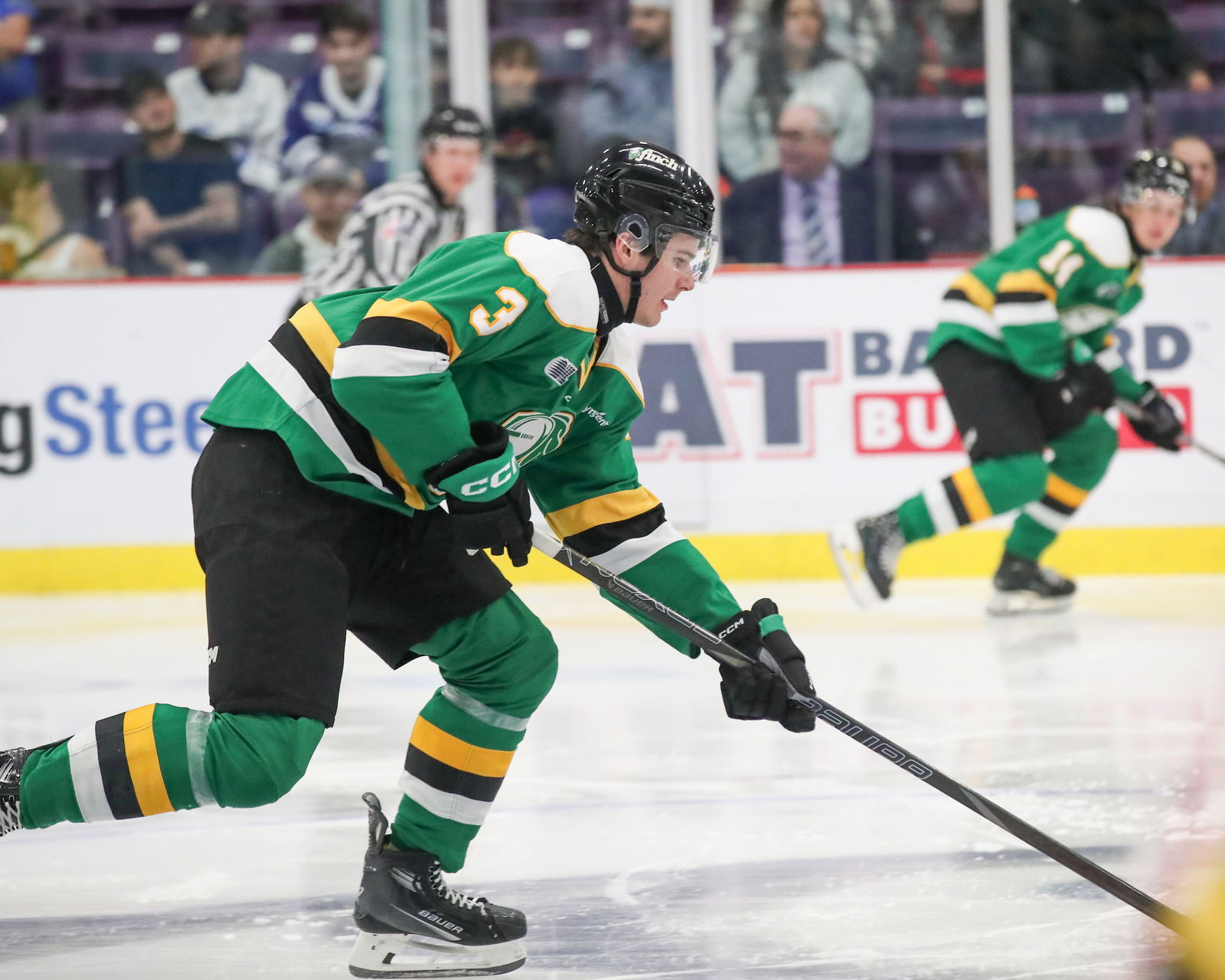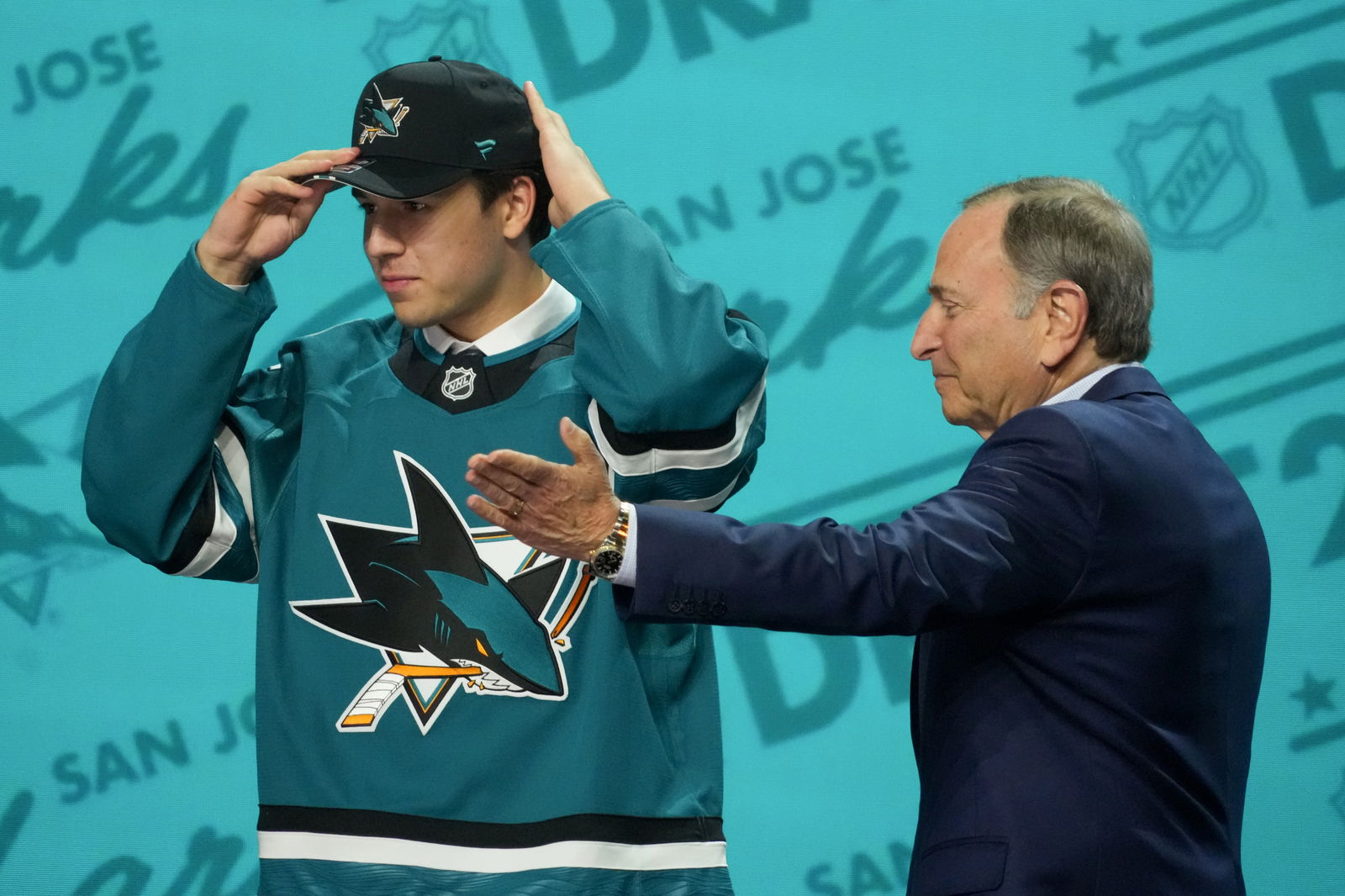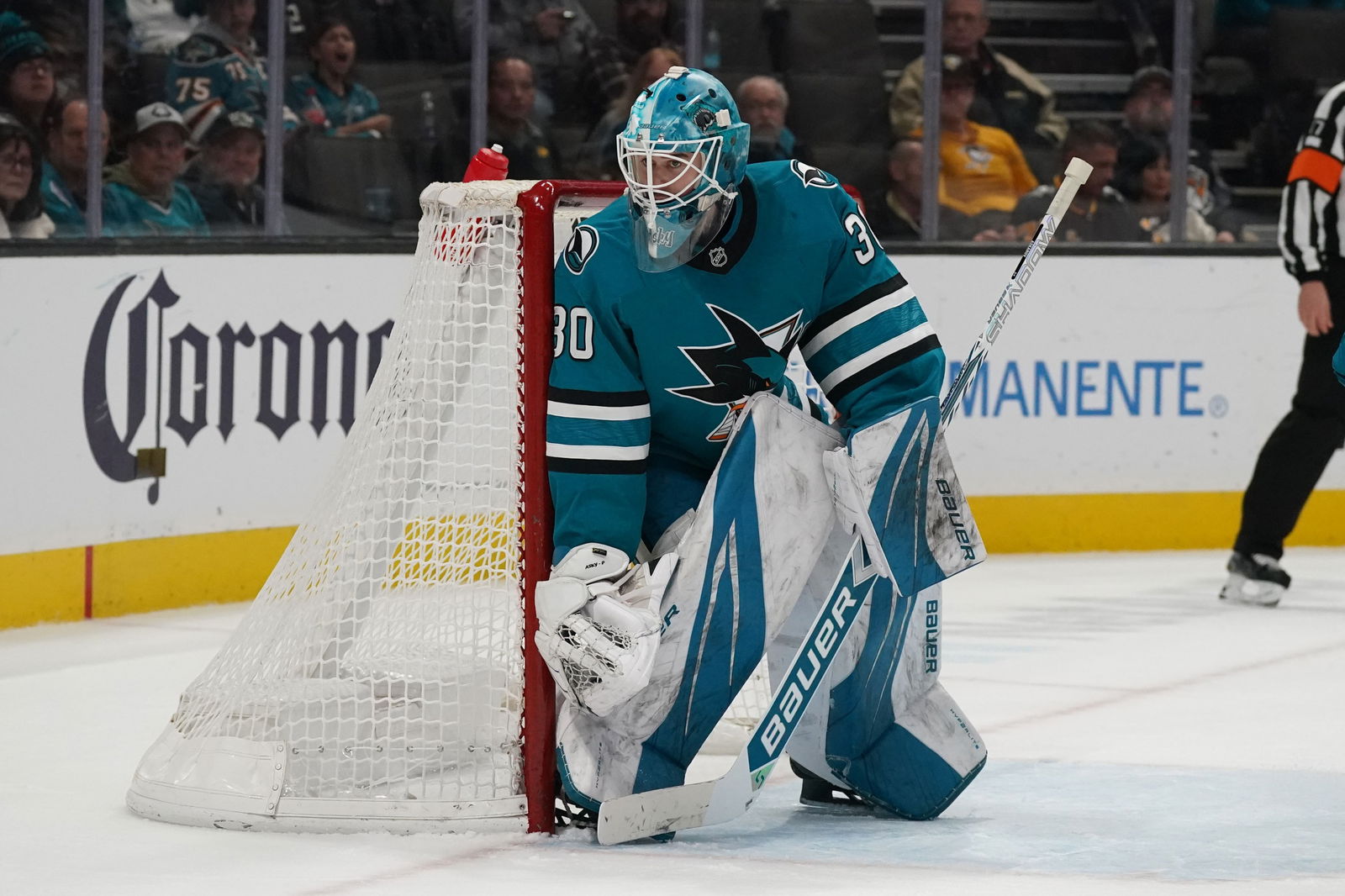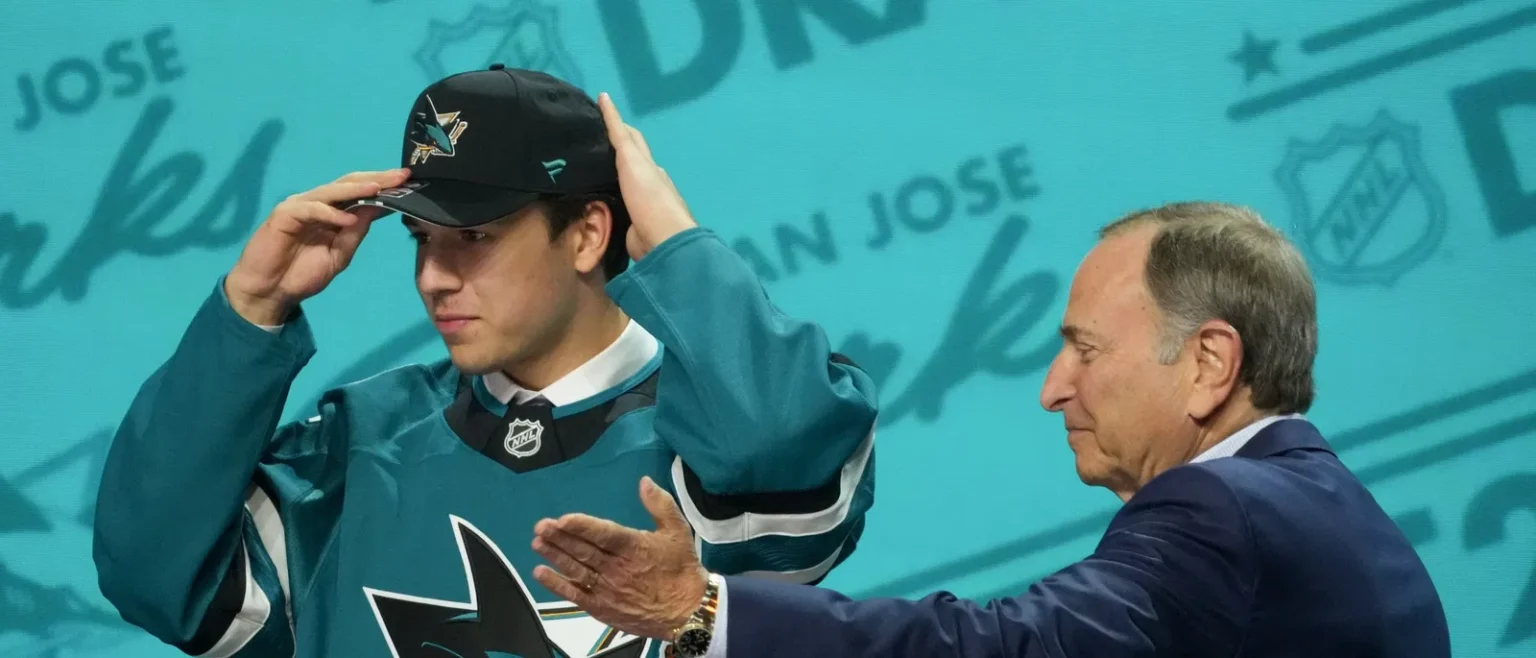The San Jose Sharks are here in the NHL prospect pool overview series.
Tony Ferrari digs into the Sharks’ strengths and weaknesses, latest draft class, positional depth chart, next player in line for an NHL opportunity and more. A player who no longer holds rookie eligibility in the NHL is considered graduated and no longer a prospect for these exercises, with few exceptions.
Initial Thoughts
The Sharks are amid a true teardown rebuild and seem to be doing it better than just about anyone, despite still being at the bottom of the standings. The vibes are high in Northern California as the Sharks had plenty to get excited about.
Macklin Celebrini was outstanding as a rookie, playing high-level hockey at both ends of the ice while finishing second in rookie scoring and rookie goals. His detail-oriented game will make him an effective NHL player for a long time. Fellow rookie Will Smith was a bit more up and down, but his run at the end of the season had people thinking the incredibly skilled and creative playmaker was hitting his stride.
On top of those two, William Eklund broke out and nearly reached the 60-point plateau for the first time. The skilled, tactical playmaking winger is the veteran among the new core, heading into his age-23 season. He has another level to hit, and many expect him to reach the 70-point mark this season.
When you get into the team’s players who are still prospects, the 2025 NHL draft class is obviously very important with Michael Misa, Joshua Ravensbergen, Haoxi ‘Simon’ Wang and Cole McKinney all likely to be important pieces moving forward. Even still, the prospect pool is loaded beyond those guys.
Last year was a weird one for Quentin Musty. It started off with a trade request that the Sudbury Wolves never granted, and he ultimately played for them. He was good for Sudbury, putting up nearly two points per game. Musty would have greatly benefited from playing in the AHL, but due to the rules at the time, he had to return to the OHL.
Despite the odd year, Musty remains one of the most intriguing prospects in the Sharks' system. His power and playmaking are intriguing aspects on the wing. He has a great shot, and he started to use it more consistently, scoring 30 goals in 33 games last year. As long as Musty stays engaged next season as an AHL rookie, he could be one of the most entertaining players on the San Jose Barracuda.
Igor Chernyshov was injured to start this past season, and many had allowed him to fade from their minds, especially because he was so highly hyped when it was announced he was coming to the OHL’s Saginaw Spirit. When he returned to the lineup, Chernyshov was an absolute monster for the Spirit, putting up 55 points in 23 games. He played alongside Misa for much of his season, and the duo picked apart the competition.
Chernyshov is a skilled winger who plays a pro-style game, working hard and winning small battles everywhere on the ice. He could build on his chemistry with Misa when they both make the NHL. Before that, Chernyshov will be a fixture in the AHL lineup this season.
When the Sharks drafted Filip Bystedt, some thought he went a bit too high, but the franchise bet on raw tools finding a way to mesh. Since his draft in 2022, Bystedt has become a very strong two-way forward who can fly up and down the ice, use his shot from all over the zone and make smart defensive plays. He’s been a leader for Sweden internationally, won the Swedish League’s rookie of the year honors and made his North American debut with the AHL Barracuda. His 12 goals and 31 points as an AHL rookie were solid. He will look to build on that and even possibly get into a few NHL games.
Sharks fans have been mesmerized by Kasper Halttunen’s play in London as he helped the Knights become back-to-back OHL champions and the Memorial Cup champions this past season. The sharpshooter has been a lethal presence in the OHL over the last couple of years. He’s a complementary player who brings some physicality and a big shot, but he has his holes as a playmaker and when defending. The Sharks have players who should insulate him and allow him to play to his strengths, which could put him in a similar role to the one he’s played in London.
Drafted in 2021 by the Colorado Avalanche, Oskar Olausson had plenty of promise as a high-end skater who loved to attack off the rush. His development stagnated in the AHL, and the Avs traded him to the Sharks for fellow prospect Danil Gushchin in July. The Sharks hope the Swedish sniper can get back on track. He’s shown flashes of being a high-end transition player with some really nice offensive skill. He’s likely going to spend the year in the AHL, but he could get an NHL opportunity if he starts strong.

The Sharks' top prospect on the blueline is Sam Dickinson, who had a dominant season in the OHL. He won the CHL’s top defenseman award while impacting play all over the ice. Defensively, he was smothering with his mobility and size. Offensively, he was cerebral at times, firing pucks to teammates in prime position to score or drawing defenders to him to open up passing lanes. There wasn’t much that he didn’t do for London en route to a second OHL title and the Memorial Cup. Dickinson will push for an NHL job in training camp after his 91-point OHL campaign leaves him with not much to prove at the junior level.
While Luca Cagnoni and Shakir Mukhamadullin played NHL games last year, the two polar-opposite defenders still have a lot to prove to secure an NHL spot.
Cagnoni is the slick, shifty, undersized defender who can pick apart an opposing team with his skating and skill. He flashed it in the NHL after having an impressive run in the AHL as a rookie. Mukhamadullin is a smooth-skating 6-foot-4 blueliner who has some offensive tools, but he is at his best when he keeps things simple and gets the puck out of trouble. His defensive game blends his mobility with a physical edge. Both will need to earn roles in the NHL, but Mukhamadullin has an easier path as a hulking defender.
In net, Yaroslav Askarov was patient in his first season in the Sharks organization. He was often the best netminder San Jose had despite some iffy numbers in the NHL, but he spent most of his season with the Barracuda, flashing his elite upside.
Askarov is a highly athletic goaltender with a ton of personality on and off the ice. He thrives when he’s pushed and loves to have fun on the ice. His time seems to have finally come as the Sharks have jettisoned most NHL talent in the crease aside from Alex Nedeljkovic, so the duo should form a nice tandem this season.
U-23 Players Likely To Be On NHL Roster This Season
Macklin Celebrini (C), Will Smith (C/W), William Eklund (C/W), Michael Misa (C)

2025 NHL Draft Class
Round 1, 2nd overall – Michael Misa, C, Saginaw (OHL)
Round 1, 30th overall – Joshua Ravensbergen, G, Prince George (WHL)
Round 2, 33rd overall – Haoxi Wang, D, Oshawa (OHL)
Round 2, 53rd overall – Cole McKinney, C, U.S. NTDP (USHL)
Round 3, 95th overall – Teddy Mutryn, C/W, Chicago (USHL)
Round 4, 115th overall – Ilyas Magomedsultanov, D, Loko Yaroslavl Jr. (Rus.)
Round 4, 124th overall – Zack Sharp, D, Western Michigan (NCAA)
Round 5, 150th overall – Max Heise, C, Penticton (BCHL)
Round 7, 210th overall – Richard Gallant, F, U.S. NTDP (USHL)
The Sharks are in the glory days of the rebuild. They’re acquiring an insane amount of talent, and this draft might have given them one of the core pieces to building a long, sustainable contender. The 2025 NHL draft may be one of the last where the Sharks are intentionally drafting at the top, so they made the best of it by snagging the best forward in the draft and adding plenty of depth to their pipeline.
Misa was drafted second overall, and the Saginaw center had the talent to go first overall. He was one of the most productive draft eligibles out of the OHL in the last 30 years, putting up 62 goals and 134 points to lead all scorers across the CHL.
Misa was arguably the best player in the CHL from start to finish. While most players go on slumps, Misa was held without a point just five times across all competition in the regular season. Misa has a chance to jump into the Sharks' lineup if he opts not to go to the NCAA because he’s accomplished everything he could have at the OHL level and more.
Misa isn’t just an offensive force, though. His defensive game is quite solid, which could make him a premier two-way center at the next level. While the Sharks already have Celebrini, with Misa in the fold as well, San Jose might have one of the most impressive center duos in the NHL. When you add in centers in the pipeline, such as Bystedt and McKinney, the Sharks could have one of the best groups of centers in the NHL. If Will Smith moves back to center from the wing, then look out.
The Sharks had another first-round pick in this draft, Ravensbergen, at 30th overall. Ravensbergen was often regarded as the top goalie in the draft class. At 6-foot-5, he is massive and takes up the net. He’s a goalie coach's dream in terms of physical tools. He skates well in net, moving well laterally and going from post to post with ease because of his size. He still has some work to do with refining some of his technique and his depth when telescoping in and out of his net, but Ravensbergen is an excellent bet when you already have Askarov about to break into the NHL.
Kicking off Day 2 of the draft, the Sharks took Wang, a very raw but incredibly talented defender. He joined OHL Oshawa after the NCAA eligibility rules changed, and it was a very good move for his development. Wang is an elite skater at his size and uses it to showcase excellent puck-rushing ability. His mobility and passing allow him to contribute at both ends of the ice, but he has plenty of refinement to do when it comes to details and defensive habits. Wang uses his size well, but he will need to read the play a bit better to reach his full potential, which is quite high.
McKinney is a great value pick in the late second round, bringing a baseline of being a very smart, high-pace, defensive center who was one of the best penalty-killers and most engaged 200-foot players in the draft. He can strip pucks in space or hunt them down in the corners. He rarely takes poor paths to the puck and always finds a way to disrupt opponents' play. His offensive game is simple but effective. A north-south attacker who showcases dual-threat ability, McKinney was often the USA Hockey National Team Development Program’s most reliable forward on a nightly basis.
Teddy Mutryn is a physical, driven forward with a heavy shot. He plays a straightforward game, looking to crash and bang, collect the puck and get shots off from all over the zone. Mutryn is a prototypical bottom-six forward. If he can add a layer of skill and work on his playmaking a bit at Boston College over the next few years, he could be a Matthew Knies-esque top-six winger.
In the fourth round, the Sharks grabbed Ilyas Magomedsultanov, a big, mobile defender who plays with an edge. He is a play-killer in his own zone, using his skating and length to close down on attackers and his physicality to eliminate the puck carrier. He isn’t much of a puckhandler, but he can get the puck back for his team. He’s a less refined Mukhamadullin in a lot of ways.
Zack Sharp had a very solid freshman season at Western Michigan, playing a depth role but helping them win a national title. He liked to activate and get involved in the play, and he will look to do that more next season. He is a jack of all trades, master of none at the moment, which could make him a decent depth piece, especially because the 20-year-old may make the move to pro hockey sooner than most prospects drafted this year.
San Jose drafted another overage player in Max Heise, a center from the Penticton Vees who brings size, physicality and some nice finishing ability, particularly around the net. He plays a power forward style of game with the puck, looking to drive to the net and protect the puck on his hip. Heise is a long shot to make the NHL, but he will head to Michigan State for the 2026-27 season, so he should have ample time to develop over the next few years.
The Sharks capped off their draft with Richard Gallant, my favorite pick of the second half of their draft. Gallant is undersized, but he’s fearless and was always making things happen for the NTDP. He plays with a relentless amount of speed and consistently puts himself in a position to make a positive play in the offensive zone, with or without the puck. There are some players who just simply know how to play hockey, and Gallant is one of them. If he weren’t 5-foot-8, he likely would have gone in the top half of the draft, if not the top two rounds.
Strengths
There may not be another team in the NHL with the young depth down the middle that the Sharks have.
Not only do they have Celebrini and Smith in the NHL already, but they also have Misa, Bystedt, and McKinney, who are all legitimate NHL center options. That might mean we see Smith move to the wing and then fill in when needed, allowing them to fit three top six centers into the top two lines.
Bystedt is coming off a solid AHL rookie season and could be a wicked third-line center down the line. McKinney is a versatile center who fits the mold of a fourth-line center who can bring value defensively and on the penalty kill.
The reality is that not every prospect works out, though. So let’s say one of those guys isn’t able to reach their potential. Well, the Sharks have a guy like Mutryn who could be a solid physical, bottom-six center. Maybe they end up with a three-headed monster down the middle by moving Smith back to center and letting things work out with three scoring lines. The Sharks might have a very good problem on their hands.
Weaknesses
The Sharks have a very strong prospect pool, and while their weakness would be closer to a strength in some of the weaker prospect pools, there does seem to be an obvious weakness at right-shot defense.
They have a number of decent enough bets, but their top player is Mattias Havelid, a prospect who might just be a hidden gem (foreshadowing?), but he’s no guarantee. Everyone beyond Havelid is a low upside swing. Maybe one or two of them work out and play some NHL games, but the likelihood that any of them will become big-time contributors is less likely. Next year might end up being the time to target some right-shot blueliners in the draft.
Hidden Gem: Mattias Havelid, D
Speaking of Havelid, he might be a very intriguing puck-moving defender who skates at a high level and can run a second power-play unit. He made an impact at the Swedish second level, and now that he’s coming to the AHL, he will have a chance to prove his worth closer to the NHL club.
Havelid is a deceptive puckhandler who can shimmy and shake off opposing defenders on the blueliners and then attack north-south into space. He presents himself as a shooting option, but when he does shoot, he shoots for sticks and tries to give his teammates a chance to deflect pucks. Havelid is at his best when he is attacking downhill off the blueline and then dishing east-west to get the goalie moving laterally. His defensive game must continue to grow, but his value will come in transition and inside the offensive blueline.

Next Man Up: Yaroslav Askarov, G, Sam Dickinson, D, And Michael Misa, C
Askarov might be the only one who seems to be guaranteed to be taking the step into the NHL, with the opportunity to start the season in a tandem with Nedeljkovic. By season’s end, Askarov will hopefully have taken over the starting gig to give the Sharks a bit of confidence with their future in net.
With Dickinson and Misa, there are questions about where they will play this season. Both have proven nearly everything they could at the OHL level, dominating in every facet of the game, so going back to the league might be redundant for their development. The AHL isn’t an option yet for either of them.
Dickinson can’t head to the NCAA for a year because he signed his entry-level contract, but Misa hasn’t yet, which means he can go to college for a year. His brother is heading to Penn State, and he’s expressed a desire to play with him, so that could be an option if the NHL isn’t in the cards.
Realistically, if it were strictly based on talent, Dickinson and Misa could probably step into this Sharks lineup, but the team is in no rush, and they can let these guys overmarinate if they need to. If I had to make a bet, we’ll see Dickinson in the NHL while Misa heads to the NCAA for a one-year stint, possibly playing alongside his brother and 2026 projected first overall pick, Gavin McKenna.
Prospect Depth Chart Notables
LW: Igor Chernyshov, Quentin Musty, Richard Gallant, Cam Lund
C: Michael Misa, Filip Bystedt, Cole McKinney, Teddy Mutryn, Yegor Spiridonov
RW: Kasper Halttunen, Carson Wetsch, Ethan Cardwell, Oskar Olausson, Yegor Rimashevskiy
LD: Sam Dickinson, Luca Cagnoni, Haoxi ‘Simon’ Wang, Leo Sahlin Wallenius, Shakir Mukhamadullin
RD: Mattias Havelid, Michael Fisher, Nate Misskey, Colton Roberts, Axel Landen, Jake Furlong, Artem Guryev
G: Yaroslav Askarov, Joshua Ravensbergen, Yaroslav Korostelyov, Christian Kirsch
For a deeper dive into the prospect pool with player rankings, check out the Yearbook and Future Watch editions of The Hockey News in print.
Read the full article here



